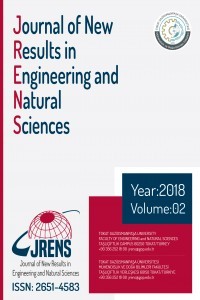Melisa Bitkisinin Melissa officinalis L. Kurutma Süresi ve Kalite Parametrelerinin Kurutma Havası Sıcaklık Profili ile Değişimi
Yüksek ilk nem içeriği %72.99 ila %80.11, yb nedeniyle, önemli ticari değere sahip tıbbi ve aromatik bitkilerden olan melisa bitkisi Melissa officinalis L. hasattan hemen sonra kurutulmalıdır. Renk ve uçucu yağ içeriği gibi kalite parametreleri kurutma koşullarına çok duyarlıdır. Kurutma havası sıcaklığı profili kurutma koşullarını etkileyen en önemli faktördür. Melisa bitkisinin kalite parametrelerini korumak ve kurutma süresini oldukça azaltmak için beş farklı kurutma havası sıcaklığı profili kullanılmıştır. Sabit düşük sıcaklık 35 °C veya artan sıcaklık profili ile kurutma denemeleri, taze örneklere en yakın renk değerlerini vermiştir. Sabit yüksek sıcaklık 60 °C ve üçgen sıcaklık profilleri ise maksimum renk değişimlerine neden olmuşlardır. Sabit düşük sıcaklıktaki kurutma denemeleri, en düşük uçucu yağ kaybına %24.28 kayıp neden olurken, sabit yüksek sıcaklıktaki kurutma deneyleri, en yüksek uçucu yağ kaybına %63.95 kayıp neden olmuştur. Bu çalışmada elde edilen sonuçlar birlikte değerlendirildiğinde, kurutma hava sıcaklığının 8 saatte 35 °C'den 60 °C'ye yükseltildiği artan sıcaklık profili, melisa bitkisinin kurutulması için en uygun kurutma havası sıcaklık profili olmuştur.
Anahtar Kelimeler:
Tıbbi ve Aromatik Bitkiler, Uçucu Yağ İçeriği, Renk Değişimi, Konvektif Sıcak Havalı Kurutma
The Change of Drying Time and Quality Parameters of Lemon Balm Melissa officinalis L. with Different Temperature Profiles of Drying Air
Lemon balm Melissa officinalis L. , one of commercially important medicinal and aromatic plants, must be dried immediately after harvest because of its high initial moisture content 72.99% to 80.11%, wb . Its quality parameters such as its color and essential oil conditions are very sensitive to drying conditions. The most important factor of drying conditions is the drying air temperature profile. Five different drying air temperature profiles were used to maintain the quality parameters of lemon balm samples while reducing the drying time as much as possible. Drying trials with the constant low temperature 35 °C and the increasing temperature profile gave the most closest color values of dried samples to the ones of fresh samples. The maximum color changes occurred with the constant high temperature 60 °C and the triangle temperature profile. The drying trials with the constant low temperature gave the lowest essential oil loss 24.28% loss while the drying trials with the constant high temperature gave the highest essential oil loss 63.95% loss . The increasing temperature profile in which the drying air temperature increased from 35 °C to 60 °C in 8 hours became the most convenient drying air temperature profile for drying lemon balm when the results obtained in this study were evaluated altogether.
Keywords:
Medicinal and Aromatic Plants, Essential Oil Content, Color Change, Convective Hot Air Drying.,
___
- [1] Arceusz A, Wesolowski M, Ulewicz-Magulska B (2015). Flavonoids and phenolicacids in methanolic extracts, ınfusions and tinctures from commercial samples of lemon balm. Natural Product Communications. 10 (6), 977-981.
- [2] Avci AB, Giachino RRA (2016). Harvest stage effects on some yield and qualitycharacteristics of lemon balm (Melissa officinalis L.). Industrial Crops and Products, 88, 23-27.
- [3] Baytop T (1984). Theraphy with plants in Turkey (Past and Today). Istanbul University Publication Number: 3255, Istanbul, Turkey. (In Turkish).
- [4] Cuervo SP, Hensel O (2008). Drying of Lemon Balm (Melissa Officinalis L.) using stepwise process control, Tropentag 2008, University of Hohenheim, 7-9 Ekim, Germany.
- [5] Pirbalouti AG, Salehi S, Craker L (2017). Effect of drying methods on qualitative and quantitavi properties of essential oil from the aerial parts of coriander. Journal of Applied Research on Medicinal and Aromatic Plants, 4:35-40.
- [6] Kumar R, Sharma S, Sharma S, Kumar N (2016). Drying methods and distillation time effects essential oil content and chemical compositions of Acorus calamus L. İn the western Himalayas. Journal of Applied Research on Medicinal and Aromatic Plants, 3:136- 141.
- [7] Orphanides A, Goulas V, Gekas V (2016). Drying technologies: Vehicle to High- Quality Herbs Food Engineering Review, 8, 164–180.
- [8] Argyropoulos D, Müller J (2014). Effect of convective-, vacuum- and freeze drying onsorption behaviour and bioactive compounds of lemon balm (Melissa officinalis L.), Journal Applied Research Medicinal Aromatic Plants, 1, 59-69.
- [9] Ebadi MT, Azizi M, Sefidkon F, Ahmadi N (2015). Influence of different drying methods on drying period, essential oil content and composition of Lippia citriodaora Kunth. Journal of Applied Research on Medicinal and Aromatic Plants. 2, 182-187.
- [10] Tarhan S, Telci Đ, Tuncay TM, Polatcı H (2011). Product quality and energy consumption when drying peppermint by rotary drum dryer. Industrial Crops and Products 32: 420– 427.
- [11] Tarhan S, Telci Đ, Tuncay TM, Polatcı H (2011). Peppermint drying performance of contact dryer in terms of product quality, energy consumption, and drying duration. Drying Technology, 29(6), 642-651.
- [12] Ozguven MM, Tarhan S, Polatcı H, Telci Đ (2016). A new way to ımprove the drying kinetics and final quality of peppermint. Journal of Essential Oil Bearing Plants, 19 (6), 1368 – 1379.
- [13] Müller J (2007). Convective drying of medicinal, aromatic and spice plants: a review. Stewart Postharvest Review, 3(4): 1-6.
- [14] McGuire RG (1992). Reporting of objective color measurements. Hort Science, 27: 1254-1255.
- Yayın Aralığı: Yılda 2 Sayı
- Başlangıç: 2013
- Yayıncı: Tokat Gaziosmanpaşa Üniversitesi
